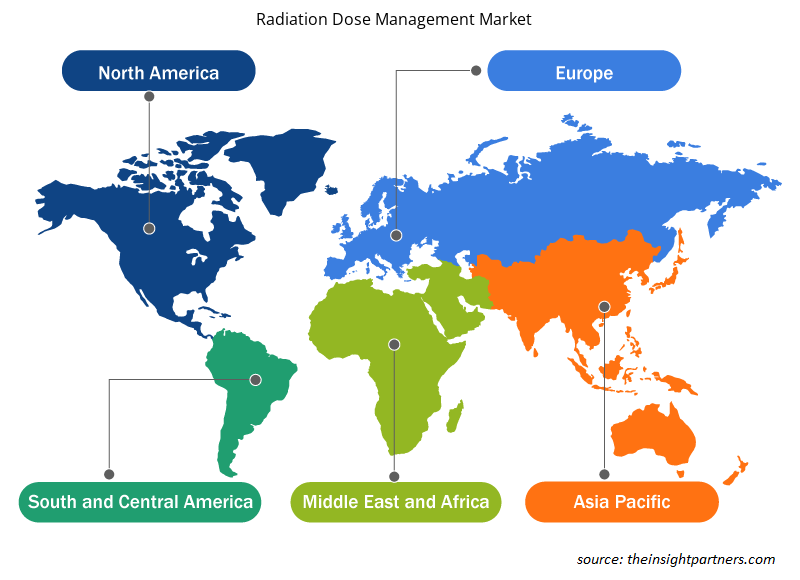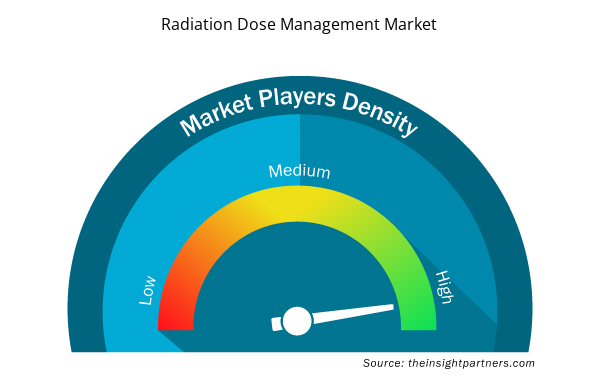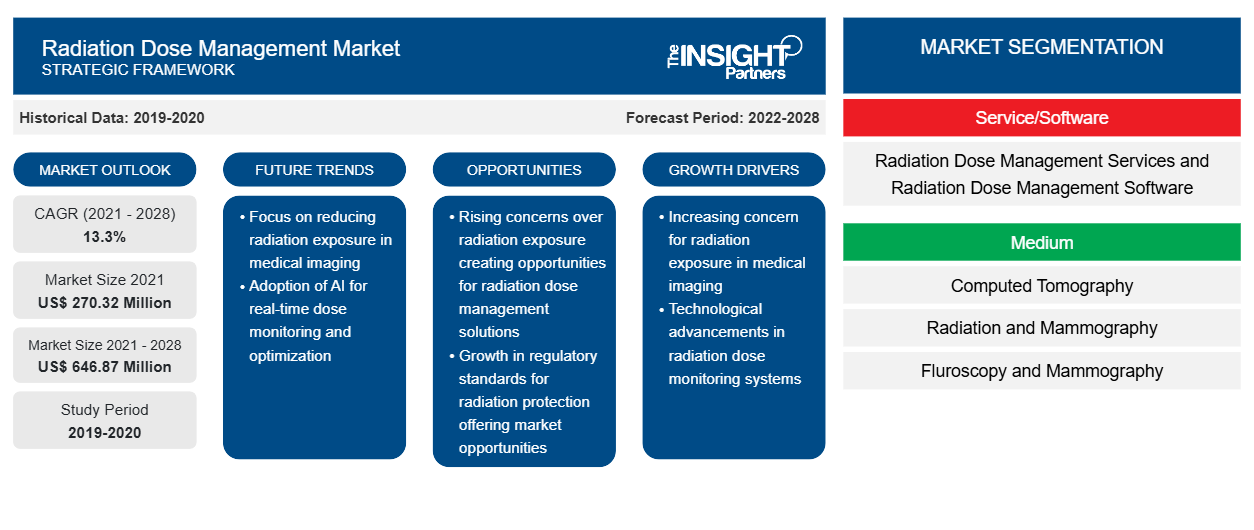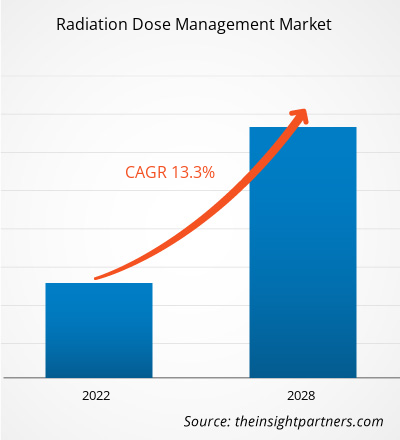放射線量管理市場は、2021年の2億7,032万米ドルから2028年には6億4,687万米ドルに達すると予測されており、2021年から2028年にかけて13.3%のCAGRで成長すると推定されています。
放射線療法は医学の重要な分野です。ガンや心血管疾患などのさまざまな病気は、電磁波によって診断され、治療されます。さまざまな種類のガンの治療に広く使用されています。しかし、放射線療法には副作用もあります。したがって、放射線を使用する医療処置では、正しい放射線量を監視することが非常に重要です。放射線量とは、患者に照射される放射線の量です。放射線量管理には、放射線量記録ソフトウェア、スタッフのリアルタイムの線量監視、規制遵守、インタラクティブな再構成ソフトウェアなどの線量低減技術に関する情報が含まれます。
放射線量管理市場の成長は、放射線被曝に関する懸念の高まりと、放射線治療を必要とする癌の症例の増加に起因しています。しかし、組織上の課題と線量最適化のベンチマークの欠如が市場の成長を妨げています。
要件に合わせてレポートをカスタマイズする
このレポートの一部、国レベルの分析、Excelデータパックなど、あらゆるレポートを無料でカスタマイズできます。また、スタートアップや大学向けのお得なオファーや割引もご利用いただけます。
- このレポートの主要な市場動向を入手してください。この無料サンプルには、市場動向から見積もりや予測に至るまでのデータ分析が含まれます。
市場分析
インターベンショナル放射線学と核医学への注目の高まり
医療技術、機器製造、および画像診断装置の急速な進歩により、より優れた技術による元の手順の改良と、手順の適応の拡大がもたらされました。新しい技術が開発され、一部の技術は他の画像診断法に移行されています。高い画像診断効率のため、世界中でより多くの介入放射線医学および核医学手順が実施されています。核医学会によると、米国では毎年約2,000万件の核医学手順が実施されています。世界原子力協会の報告によると、世界中で10,000以上の病院が医療に放射性同位元素を使用しており、放射性同位元素手順の90%は診断です。バイエルヘルスケアやセクトラメディカルシステムズなどの市場プレーヤーは、介入画像診断および核医学におけるRDM専用の線量管理ソフトウェアを提供しています。したがって、介入放射線学および核医学への注目の高まりは、市場の成長の機会を提供しています。
サービス/ソフトウェアベースの洞察
サービス/ソフトウェアに基づいて、世界の放射線量管理市場は、放射線量管理サービスと放射線量管理ソフトウェアに分類されています。放射線量管理ソフトウェアセグメントは、2021年に市場で最大のシェアを占め、予測期間中に市場で13.6%のCAGRを記録すると予想されています。
メディアベースの洞察
媒体に基づいて、世界の放射線量管理市場は、コンピューター断層撮影、放射線とマンモグラフィー、透視とマンモグラフィー、およびその他の媒体に分類されます。コンピューター断層撮影セグメントは2021年に市場で最大のシェアを占め、予測期間中に市場で13.8%のCAGRを記録すると予想されています。
放射線量管理市場の地域別分析
予測期間を通じて放射線量管理市場に影響を与える地域的な傾向と要因は、Insight Partners のアナリストによって徹底的に説明されています。このセクションでは、北米、ヨーロッパ、アジア太平洋、中東、アフリカ、南米、中米にわたる放射線量管理市場のセグメントと地理についても説明します。

- 放射線量管理市場の地域別データを入手
放射線量管理市場レポートの範囲
| レポート属性 | 詳細 |
|---|---|
| 2021年の市場規模 | 2億7,032万米ドル |
| 2028年までの市場規模 | 6億4,687万米ドル |
| 世界のCAGR(2021年~2028年) | 13.3% |
| 履歴データ | 2019-2020 |
| 予測期間 | 2022-2028 |
| 対象セグメント | サービス/ソフトウェア別
|
| 対象地域と国 | 北米
|
| 市場リーダーと主要企業プロフィール |
|
放射線量管理市場のプレーヤー密度:ビジネスダイナミクスへの影響を理解する
放射線量管理市場は、消費者の嗜好の変化、技術の進歩、製品の利点に対する認識の高まりなどの要因により、エンドユーザーの需要が高まり、急速に成長しています。需要が高まるにつれて、企業は提供内容を拡大し、消費者のニーズを満たすために革新し、新たなトレンドを活用し、市場の成長をさらに促進しています。
市場プレーヤー密度とは、特定の市場または業界内で活動している企業または会社の分布を指します。これは、特定の市場スペースに、その規模または総市場価値と比較して、どれだけの競合相手 (市場プレーヤー) が存在するかを示します。
放射線量管理市場で事業を展開している主要企業は次のとおりです。
- 富士フイルムホールディングス株式会社
- バイエルAG
- ブラッコイメージングSpA
- GEヘルスケア
- フィリップスNV
免責事項:上記の企業は、特定の順序でランク付けされていません。

- 放射線量管理市場のトップキープレーヤーの概要を入手
エンドユーザーベースの洞察
エンドユーザーに基づいて、放射線量管理市場は病院、研究・医療機関、その他に区分されています。病院セグメントは2021年に市場で最大のシェアを占め、予測期間中に市場で最高のCAGR 13.6%を記録すると予測されています。
製品の発売と承認は、企業が世界的な足跡と製品ポートフォリオを拡大するために一般的に採用されている戦略です。さらに、放射線量管理市場のプレーヤーは、顧客を拡大するためのパートナーシップ戦略に重点を置いており、これにより世界中でブランド名を維持できます。
企業プロフィール
- 富士フイルムホールディングス株式会社
- バイエルAG
- ブラッコイメージングSpA
- GEヘルスケア
- フィリップスNV
- メッドスクエア
- ノバラッド株式会社
- 株式会社QAELUM
- セクトラAB
- PACSHealth LLC について
- 過去2年間の分析、基準年、CAGRによる予測(7年間)
- PEST分析とSWOT分析
- 市場規模価値/数量 - 世界、地域、国
- 業界と競争環境
- Excel データセット


- Surgical Gowns Market
- Airline Ancillary Services Market
- Hair Wig Market
- Cling Films Market
- Investor ESG Software Market
- Quantitative Structure-Activity Relationship (QSAR) Market
- Artwork Management Software Market
- Maritime Analytics Market
- Industrial Valves Market
- Medical and Research Grade Collagen Market

Report Coverage
Revenue forecast, Company Analysis, Industry landscape, Growth factors, and Trends

Segment Covered
This text is related
to segments covered.

Regional Scope
North America, Europe, Asia Pacific, Middle East & Africa, South & Central America

Country Scope
This text is related
to country scope.
よくある質問
The Radiation Dose Management software segment dominated the global radiation dose management market and held the largest revenue share of 77.67% in 2021.
Radiation dose management involves services and software that keep records of the radiation doses, real time dose monitoring, regulatory compliance. It is an information technology which is considerate in lowering the dose with integrative reconstruction software. The software assists to find the right way to radiation dose for a patient to get treated by the integration of medical technology and insightful data & services.
Key factors that are driving the growth of this market are growing concerns related to radiation exposure, and rising cases of cancer demanding radiation therapy.
The Computed Tomography segment dominated the global radiation dose management market and held the largest revenue share of 42.54% in 2021.
The hospitals segment dominated the global radiation dose management market and accounted for the largest revenue share of 51.14% in 2021.
Global radiation dose management market is segmented by region into North America, Europe, Asia Pacific, Middle East & Africa and South & Central America. In North America, the U.S. is the largest market for radiation dose management. The market growth in the country is attributed to the factors such as the stringent legislative and accreditation requirements regarding the reporting and optimization of radiation doses, high adoption of HCIT technologies, and the presence of stringent regulatory requirements regarding patient safety. And, North America is the fastest-growing region growing at the CAGR of 13.8% during the forecast period.
The radiation dose management market majorly consists of the players such as FUJIFILM Holdings Corporation; Bayer AG; Bracco Imaging S.p.A; GE Healthcare; Koninklijke Philips N.V.; Medsquare; Novarad Corporation; QAELUM INC; Sectra AB; PACSHealth, LLC: among others.
Trends and growth analysis reports related to Technology, Media and Telecommunications : READ MORE..
List of Companies - Radiation Dose Management Market
- FUJIFILM Holdings Corporation
- Bayer AG
- Bracco Imaging S.p.A
- GE Healthcare
- Koninklijke Philips N.V.
- Medsquare
- Novarad Corporation
- QAELUM INC
- Sectra AB
- PACSHealth, LLC
The Insight Partners performs research in 4 major stages: Data Collection & Secondary Research, Primary Research, Data Analysis and Data Triangulation & Final Review.
- Data Collection and Secondary Research:
As a market research and consulting firm operating from a decade, we have published and advised several client across the globe. First step for any study will start with an assessment of currently available data and insights from existing reports. Further, historical and current market information is collected from Investor Presentations, Annual Reports, SEC Filings, etc., and other information related to company’s performance and market positioning are gathered from Paid Databases (Factiva, Hoovers, and Reuters) and various other publications available in public domain.
Several associations trade associates, technical forums, institutes, societies and organization are accessed to gain technical as well as market related insights through their publications such as research papers, blogs and press releases related to the studies are referred to get cues about the market. Further, white papers, journals, magazines, and other news articles published in last 3 years are scrutinized and analyzed to understand the current market trends.
- Primary Research:
The primarily interview analysis comprise of data obtained from industry participants interview and answers to survey questions gathered by in-house primary team.
For primary research, interviews are conducted with industry experts/CEOs/Marketing Managers/VPs/Subject Matter Experts from both demand and supply side to get a 360-degree view of the market. The primary team conducts several interviews based on the complexity of the markets to understand the various market trends and dynamics which makes research more credible and precise.
A typical research interview fulfils the following functions:
- Provides first-hand information on the market size, market trends, growth trends, competitive landscape, and outlook
- Validates and strengthens in-house secondary research findings
- Develops the analysis team’s expertise and market understanding
Primary research involves email interactions and telephone interviews for each market, category, segment, and sub-segment across geographies. The participants who typically take part in such a process include, but are not limited to:
- Industry participants: VPs, business development managers, market intelligence managers and national sales managers
- Outside experts: Valuation experts, research analysts and key opinion leaders specializing in the electronics and semiconductor industry.
Below is the breakup of our primary respondents by company, designation, and region:

Once we receive the confirmation from primary research sources or primary respondents, we finalize the base year market estimation and forecast the data as per the macroeconomic and microeconomic factors assessed during data collection.
- Data Analysis:
Once data is validated through both secondary as well as primary respondents, we finalize the market estimations by hypothesis formulation and factor analysis at regional and country level.
- Macro-Economic Factor Analysis:
We analyse macroeconomic indicators such the gross domestic product (GDP), increase in the demand for goods and services across industries, technological advancement, regional economic growth, governmental policies, the influence of COVID-19, PEST analysis, and other aspects. This analysis aids in setting benchmarks for various nations/regions and approximating market splits. Additionally, the general trend of the aforementioned components aid in determining the market's development possibilities.
- Country Level Data:
Various factors that are especially aligned to the country are taken into account to determine the market size for a certain area and country, including the presence of vendors, such as headquarters and offices, the country's GDP, demand patterns, and industry growth. To comprehend the market dynamics for the nation, a number of growth variables, inhibitors, application areas, and current market trends are researched. The aforementioned elements aid in determining the country's overall market's growth potential.
- Company Profile:
The “Table of Contents” is formulated by listing and analyzing more than 25 - 30 companies operating in the market ecosystem across geographies. However, we profile only 10 companies as a standard practice in our syndicate reports. These 10 companies comprise leading, emerging, and regional players. Nonetheless, our analysis is not restricted to the 10 listed companies, we also analyze other companies present in the market to develop a holistic view and understand the prevailing trends. The “Company Profiles” section in the report covers key facts, business description, products & services, financial information, SWOT analysis, and key developments. The financial information presented is extracted from the annual reports and official documents of the publicly listed companies. Upon collecting the information for the sections of respective companies, we verify them via various primary sources and then compile the data in respective company profiles. The company level information helps us in deriving the base number as well as in forecasting the market size.
- Developing Base Number:
Aggregation of sales statistics (2020-2022) and macro-economic factor, and other secondary and primary research insights are utilized to arrive at base number and related market shares for 2022. The data gaps are identified in this step and relevant market data is analyzed, collected from paid primary interviews or databases. On finalizing the base year market size, forecasts are developed on the basis of macro-economic, industry and market growth factors and company level analysis.
- Data Triangulation and Final Review:
The market findings and base year market size calculations are validated from supply as well as demand side. Demand side validations are based on macro-economic factor analysis and benchmarks for respective regions and countries. In case of supply side validations, revenues of major companies are estimated (in case not available) based on industry benchmark, approximate number of employees, product portfolio, and primary interviews revenues are gathered. Further revenue from target product/service segment is assessed to avoid overshooting of market statistics. In case of heavy deviations between supply and demand side values, all thes steps are repeated to achieve synchronization.
We follow an iterative model, wherein we share our research findings with Subject Matter Experts (SME’s) and Key Opinion Leaders (KOLs) until consensus view of the market is not formulated – this model negates any drastic deviation in the opinions of experts. Only validated and universally acceptable research findings are quoted in our reports.
We have important check points that we use to validate our research findings – which we call – data triangulation, where we validate the information, we generate from secondary sources with primary interviews and then we re-validate with our internal data bases and Subject matter experts. This comprehensive model enables us to deliver high quality, reliable data in shortest possible time.


 このレポートの無料サンプルを入手する
このレポートの無料サンプルを入手する